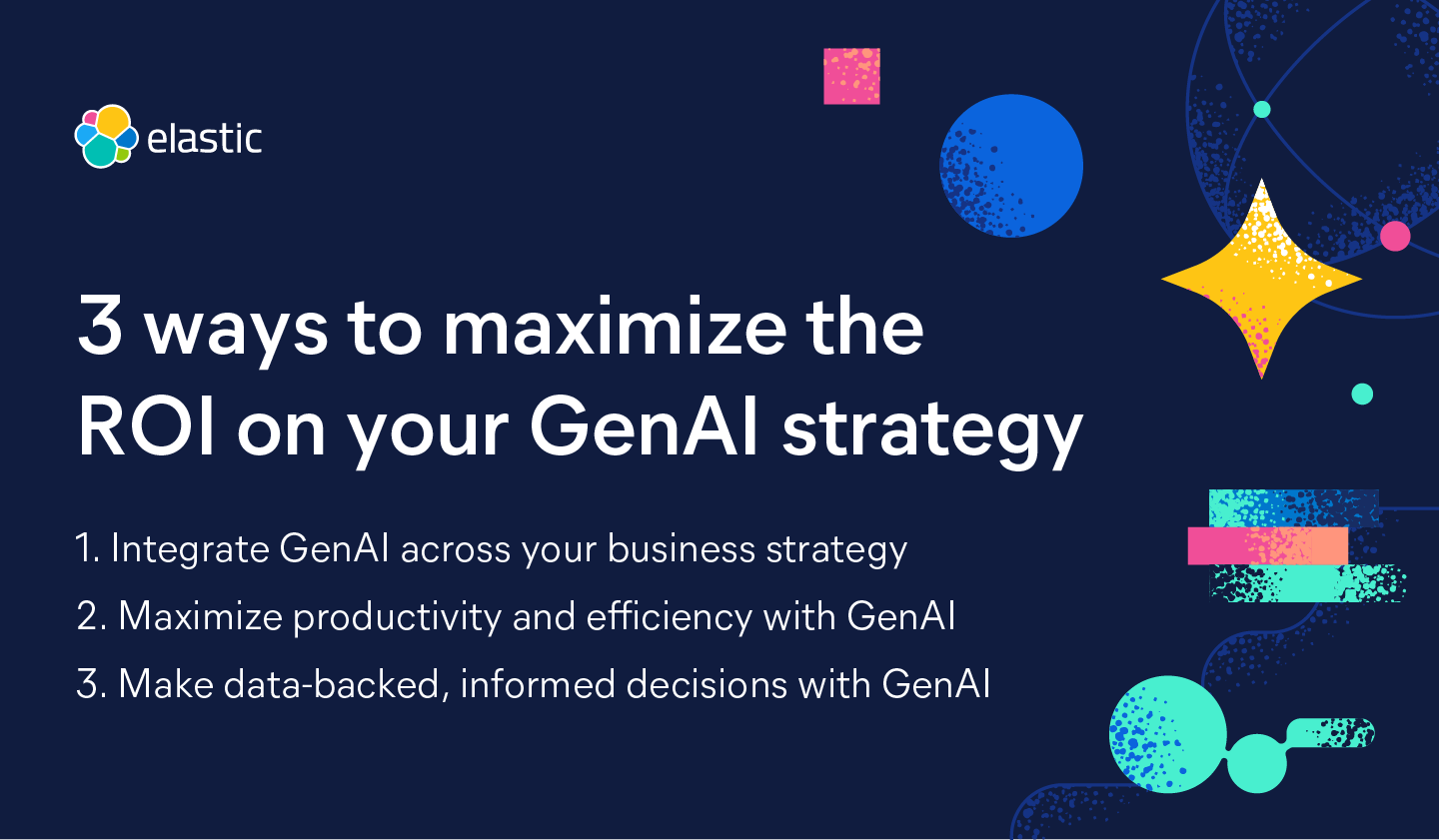3 ways to maximize the ROI on your generative AI strategy

As a CIO, I’m constantly seeking ways to balance cost efficiency with transformative technology. Generative AI (GenAI) promises impressive use cases, but as the owner of Elastic’s data, information, and technology risk, I need to ensure it delivers real, measurable value to my organization that is sustainable. We’re moving beyond the hype and ensuring our generative AI strategy is not only integrated into the fabric of our business, but drives measurable ROI.
So, how do you do that? To start, you’ll need to shift your perspective of generative AI. It’s not just a one-and-done project, but rather a fundamental part of your business strategy. You’ll want to go from one-off generative AI projects to having a holistic generative AI strategy that produces sustainable business impact. This takes shape in multiple ways across your business.

1. Integrate GenAI across your business strategy
Every single company should be exploring and putting generative AI in its products and services. Whether you’re a telecommunications provider using generative AI to enhance customer support experiences or a retailer using generative AI to help your customers find products faster, you should be exploring ways that it can help your business and your customers. However, as you do this, you will need to ensure that what you do is not only differentiated but is accurate, is consistent, scales, performs, and is measurable. This means choosing the right tools to build into this fabric are just as critical as the experiences they will provide. How are you going to operate and maintain them? What are other factors you should think about?
At Elastic, ensuring that any products or services we offer are generative AI-enabled is crucial. This isn’t just about adding generative AI and natural language processing (NLP) features — it’s about rethinking how we deliver value to our customers and staying ahead of the competition. We happen to have a great foundation for generative AI — our Search AI technology — which is a common fabric upon which we build generative AI into our different products and solutions.
For example, we have not only put the Elastic AI Assistant into our Observability solution, we also have it in our Security solution, and soon it will be available in our Search solution. We’re able to do this because they share the same underlying platform. And moreover, it’s not just AI assistants — we’re also reimagining the users’ workflow and using generative AI in the background to completely change what the user experiences. For instance, we’re reimagining a security analyst’s experience through Attack Discovery, which again, is built on top of our common Search AI Platform. You can think of putting GenAI in your products and services as the numerator in our equation — a driver for top-line growth.
2. Maximize productivity and efficiency with GenAI
Generative AI also allows us to drive efficiency, extend our reach, and simplify operations across the organization when we use the right data. This isn’t just cost-saving — it enables our teams to do more and improves overall productivity. For example, my team, among other teams at my company, is putting generative AI models and our proprietary data to work. From augmenting sales teams with a SalesGPT to streamlining customer support to helping write marketing emails and more, we’re continuing to hone our strategy and our use cases to help our teams now and create a competitive advantage. Cisco has done something similar by using our Search AI technology to help its support engineers search for similar cases in real time to solve customers’ problems. The new search capabilities have enabled Cisco to save 5,000 hours per month of support engineer time.
But these internal use cases should not be viewed as independent projects. It’s easy for individual teams and departments to dive head first into generative AI projects, buy things off the shelf, and build their own solution, but the tech sprawl will quickly grow out of control. Again, you need to think about the fundamentals: Start with identifying the data you want to use, find the commonality between all these different use cases, and come up with a plan that could scale and be sustainable to operate and maintain.
By adopting generative AI to automate routine tasks, generate insights, and support our teams in real time, we’ve been able to unlock significant productivity gains and reduce operational costs, ultimately boosting the ROI on our generative AI initiative. And at this stage, it’s hard to even call it a “generative AI initiative.” It’s really part of the foundation of our business strategy. It’s completely embedded into everything we do. This phase of optimization is the denominator in our equation — enabling us to reduce costs while enhancing output.
3. Make data-backed, informed decisions with GenAI
In the near future, I believe generative AI will empower us to make better, faster, and more informed decisions that impact critical business outcomes. You can think of this as the multiplier effect that can truly take your organization to the next level by making every decision count. In this step, we focus on what to buy, build, sell, and invest in.
For instance, your company might employ generative AI models to rapidly generate and analyze different product concepts based on customer preferences, market trends, and competitor data. This would allow your business to quickly decide which product to build and allocate resources to. You’d save time on manual analysis while ensuring that each decision is backed by data-driven, actionable insights.
Another example, imagine you’re contemplating buying another company. With a generative AI model that is fed your proprietary data including financial information, company goals, and external market conditions, you can ask the generative AI model if buying the company is the right investment at this time. With the power of your proprietary data, your model will have the data it needs to propose a data-backed, informed decision. By leveraging generative AI in this way, your company can reduce risks, prioritize high-impact projects, and accelerate time-to-market, ultimately boosting ROI.
In order to do this, you need to make sure you have the right data to feed your large language models (LLMs) and the right technology to facilitate this. At Elastic, we combine the precision that search technology brings to the table with the intelligence of AI to facilitate retrieving the data that is best fit for the job to the LLM.
What to avoid to maximize ROI on your generative AI strategy
To ensure a strong ROI from your generative AI initiative, avoid jumping into implementation without a clear business problem or objective. Many businesses make the mistake of treating generative AI as a trend rather than a tool with specific use cases that can span your entire organization. Avoid looking at your generative AI project as a one-and-done.
If you create a messy ecosystem of one-off apps, everything will be decentralized. And when it comes to compliance, you will struggle. Laws about generative AI are coming. If you can’t tell your customers how generative AI touches their experience, you’re going to be paying hefty fines and/or a lot of money to untangle your web.
How to get started with GenAI
Remember, these aren’t separate efforts — they all come together to form one unified approach. Success in AI requires that these pillars work in harmony, reinforcing each other to deliver sustainable impact. With the goal to just get pilots off the ground, you’ll be left with many independent projects and programs. True success is when everything is working together.
To optimize generative AI applications for real-world scenarios and growth, we should focus our efforts on the fundamentals — data. Because if you think about it, central to all generative AI projects is data — bringing it together and making it accessible when and where it’s needed. Having a solid data strategy is essential. Without unified and accessible data, even the most advanced generative AI initiatives will struggle to deliver real value. At the end of the day, data accessibility is the key to turning generative AI initiatives into sustainable impact.
At Elastic, we’re here to help you bring your generative AI initiative from pilot to sustainable business impact. Download the ebook to get started.
The release and timing of any features or functionality described in this post remain at Elastic's sole discretion. Any features or functionality not currently available may not be delivered on time or at all.
In this blog post, we may have used or referred to third party generative AI tools, which are owned and operated by their respective owners. Elastic does not have any control over the third party tools and we have no responsibility or liability for their content, operation or use, nor for any loss or damage that may arise from your use of such tools. Please exercise caution when using AI tools with personal, sensitive or confidential information. Any data you submit may be used for AI training or other purposes. There is no guarantee that information you provide will be kept secure or confidential. You should familiarize yourself with the privacy practices and terms of use of any generative AI tools prior to use.
Elastic, Elasticsearch, ESRE, Elasticsearch Relevance Engine and associated marks are trademarks, logos or registered trademarks of Elasticsearch N.V. in the United States and other countries. All other company and product names are trademarks, logos or registered trademarks of their respective owners.


